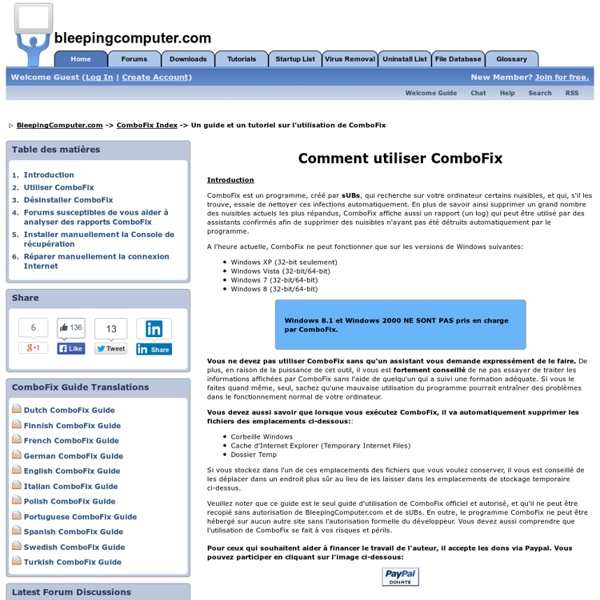Un guide et un tutoriel sur l'utilisation de ComboFix

Tout sur Free et Wordpress - Tutoriel | Lashon, Wordpress Langag
Tout hébergement gratuit impose des limites, mais bien configuré Free est le plus fiable des gratuits. Sommaire IntroductionProblème de page blancheActiver votre site et MySQL chez FreeConfigurer php5 et .htaccessConfigurer wp-config et remplir formulaire installationRestrictions avec FreeLes permaliens chez FreeLiens utiles pour FreeAccès à votre SQLEn cas de problèmesRésumé installation update octobre 2010 : Article totalement modifié avec ajouts réponses aux problèmes et particularités. update février 2012 : la versionSQL et PHP chez Free.fr est obsolète. Intro Recensement des points essentiels à savoir, à faire, et liens utiles pour réussir un bon mariage entre WordPress et la version gratuite de l’hébergeur Free. Tous les serveurs gratuits ont leurs limitations techniques par rapport à un serveur payant. Un giga de place, gratuit à vie. Et quand je dis à vie c’est même un peu plus… Le site web sur Free d’un copain décédé demeure en ligne depuis des années. les tags complets (<?
Ext2read - View ext2/3/4 partitions from Windows
Memory Fox
PeerBlock – Peerblock Site - Firefox
Enlightenment - Beauty at your fingertips - Firefox
Soulseek - Slsknet - File sharing software - Firefox
MozBackup - Backup tool for Firefox and Thunderbird
Thunderbird backup, Firefox backup MozBackup is not being developed anymore. There are known issues and there is no time on my side to fix all issues and develop new features. Use MozBackup only on your risk. Download This software is provided "as-is," without any express or implied warranty. This software isn't developed by Mozilla Corporation. Latest stable version: 1.5.1 (Changelog), size: 1 MB, PAD file, MD5 Checksums. Older versions you can download from archive. Release notes MozBackup supports these applications: Firefox 1.0 or newer Thunderbird 1.0 or newer Sunbird 0.3 - 0.9 Flock 1.0 - 2.6 Postbox (Express) 1.0 or newer SeaMonkey 1.0a or newer Mozilla Suite 1.7 - 1.7.x Spicebird 0.4 - 0.8 Songbird 1.0 or newer Netscape 7.x, 9.x Wyzo If you have any questions please use support section. Mailing list You can use the official mailing list mozbackup@freelists.org for announcements of new releases.
JDMCOX Software
Contourner un pare-feu avec FrozenWay
Nicotine+
Test du Chromebook de Samsung !
3 façons d'accéder à vos partitions Linux depuis Windows
Si vous êtes en dual-boot Windows et Linux, vous aurez probablement envie d'accéder à des fichiers sur votre système Linux à partir de Windows à un moment donné. Linux a un support intégré pour les partitions NTFS de Windows, mais Windows ne peut pas lire les partitions Linux sans logiciel tiers. Cette liste se concentre sur les applications qui prennent en charge le système de fichiers Ext4, qui la plupart des nouvelles distributions Linux utilisent par défaut. Ces applications tout l'appui et Ext2 Ext3, trop - et l'un d'entre eux prend même en charge ReiserFS. Ext2Fsd Ext2Fsd est un pilote Windows pour le système de fichiers Ext2, Ext3, Ext4 et les systèmes de fichiers. Il permet à Windows de lire les systèmes de fichiers Linux natif, permettant d'accéder au système de fichiers via une lettre de lecteur que tout programme peut accéder. L'application Volume Ext2 Manager vous permet de définir des points de montage pour vos partitions Linux et modifier les paramètres de Ext2Fsd.
Related:
Related:



